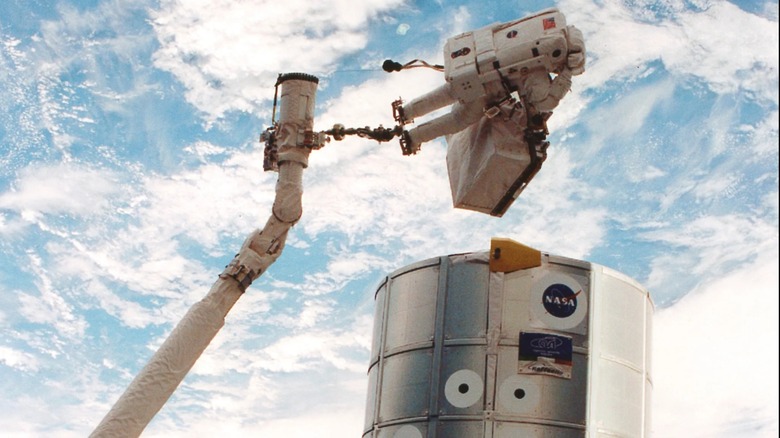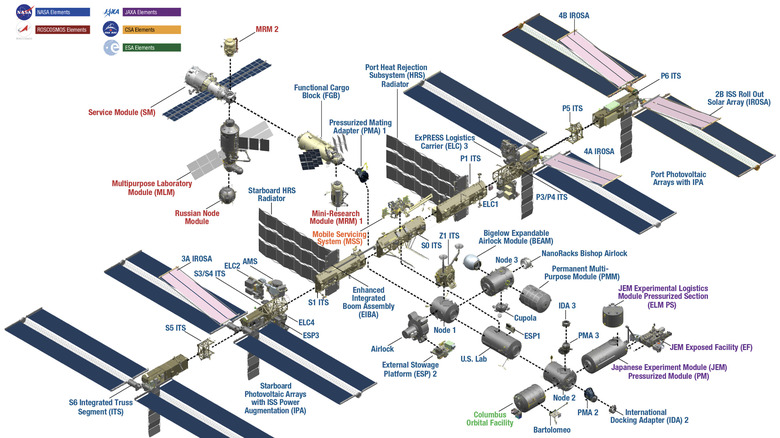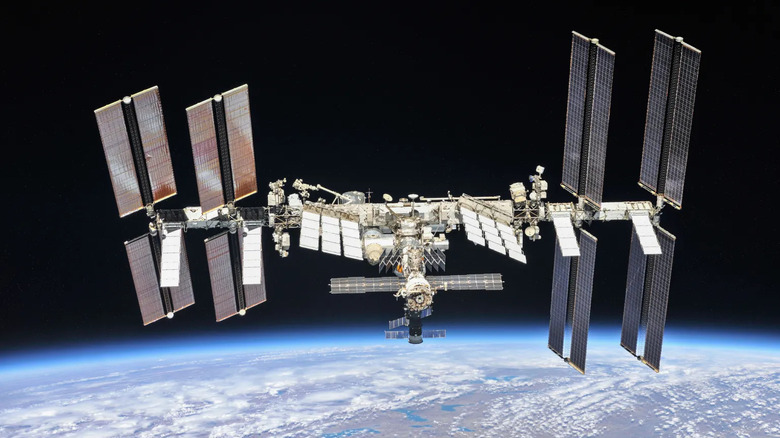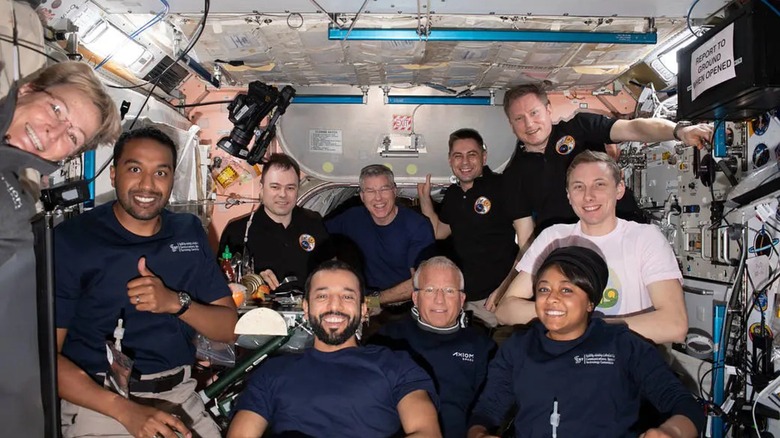How Was The International Space Station Built? (And How Long Did It Take?)
For the past 25 years, the entire living human population has never been on Planet Earth at the same time. That's because, since 2000, at least a few humans have been living aboard the International Space Station (ISS), which has been continuously inhabited by astronauts for the past quarter-century. However, plans for the ISS began well before humans permanently took residence within the structure — and its construction was no simple feat.
The ISS is an orbital laboratory built to facilitate learning about and performing experiments in space, as well as explore innovative new technologies. While there have been previous space stations, such as Skylab, the current ISS was originally greenlit in 1984 by President Reagan. Once Congress approved funding, NASA sought out international partners to help develop the station — making it a true global effort, as it would take a lot of work, clever engineering, and of course, money. It wasn't long before the European Space Agency (ESA), Japan, and Canada joined NASA in designing the ISS. After the fall of the Soviet Union, Russia also began collaborating with this group in planning the ISS, and redesign plans were completed in 1993.
Today, the ISS isn't considered to be "owned" by NASA or the U.S., or any other individual countries. Instead, it's considered cooperatively run and maintained by these international partners. Construction had begun on parts of the ISS starting in the late 1980s, before designs were completed or finalized. According to NASA, however, the main construction of the International Space Station was conducted between 1998 and 2011. Going by these official dates, it took about 13 years to build the International Space Station. Clearly, this wasn't done all at once. Instead, the ISS was built piece-by-piece, over the course of dozens of missions to space.
NASA says the ISS was built like a Lego set
Building an orbiting space station nearly 250 miles above the Earth's surface is very different from constructing a house or even a skyscraper. Because space travel is costly and, as evidenced by multiple mission failures and accidents — difficult, shooting a building-sized structure into orbit isn't very feasible. Instead, the ISS was built piece-by-piece, with its components then attached in zero gravity. As NASA puts it, the ISS was assembled "like a Lego set." Parts of the station were built in various countries around the world.
Astronauts needed to perform dangerous spacewalks to make connections, including electrical wires and fluid lines. Complex robotics were also used in the station's construction. Complicating things further, the ISS zooms around the Earth once every 90 minutes, traveling around 17,500 mph. At this speed, the ISS could reach the Moon and back in a single day. The station is also continuously being pulled back down to Earth by gravity and must repeatedly fire rockets to stay in orbit. This needed to be taken into consideration while sending pieces of the ISS to the right place and assembling them.
Some pieces were sent up on rockets, while heavier sections were carried on the Space Shuttle. A total of 42 space flights (37 on U.S. shuttles and five on Russian rockets) were needed to deliver all the major components of the structure — including structural supports, solar panels, and modules for living quarters and laboratories. In 2001, a large robotic arm was sent up and then attached to the ISS. While the International Space Station has been considered "complete" for some time now, it has received upgrades and extensions since then. In 2021, a multipurpose lab module and a Russian docking module were integrated into the station.
Just how big is the International Space Station?
Using this "Lego" like method, NASA and its scientific partners were able to build the largest human-made object to ever orbit Earth. While the number fluctuates depending on supplies and personnel, it has an average mass of about 900,000 pounds and measures 358 feet across and 168 feet long. That means it's roughly the size of a football field.
A lot of this space is taken up by the massive solar panels that power the station. These solar arrays collectively cover an acre of surface area and can generate 735,000 kWh of electricity annually. Eight miles of wire criss-cross around the ISS to keep it running. Its largest robotic arm, which can extend from the station and even hold spacecraft that can't dock with the station, is 55-feet long. Eight ships can be connected to the ISS simultaneously.
While it's no mansion, there is 13,696 cubic feet of habitable space inside the ISS for its crew members and visitors, with seven permanent sleeping quarters, two bathrooms, a gym, and a panoramic bay window with stunning views of the Earth. There's even room for additional sleeping quarters for crew changes. The current occupation record for the ISS is 13 people aboard at once, which has occurred a few times. While additional oxygen can be created from water using electrolysis, the astronauts aboard the ISS receive supplemental air along with other vital necessities, such as food and water, from occasional supply runs from the surface. A lot of air and H2O are also continuously recycled — including sweat, urine, and wastewater — which is just one of the weird things that come with living on the ISS.
How long will the ISS last?
Since 1998, over 250 people from at least 20 different nations have visited or lived aboard the ISS. Thousands of different experiments and scientific investigations have taken place on the station by researchers in more than 108 countries. But, the ISS won't last forever. Currently, NASA plans for the ISS to continue to be used for research until at least 2030, but its future after that is uncertain. For one thing, it costs around $3 billion per year just to operate the International Space Station, which is a third of NASA's human spaceflight budget.
With a new administration and global economic uncertainties ahead, it remains to be seen if the ISS can continue to be funded. Plus, Russia — which is currently in a war with Ukraine — plans to withdraw from the ISS in the next few years and instead build its own space station. Russia currently handles most of the propulsion maneuvers necessary to keep the ISS in orbit, so NASA will need to figure out how to operate the station without that country.
NASA is also considering more advanced space stations to replace the ISS, such as the Lunar Gateway. The agency will likely partner with private space companies on the ISS's successor. Some companies, such as Vast, also plan to build private space stations, while other nations may construct their own as Russia plans to do. Eventually, the ISS may be stripped for parts and recycled for other space stations or carefully deorbited back down to Earth. Considering the lifespan of the ISS has been extended more than once, however, it could very well keep on running for a while. If new modules are added, you could even argue that the construction of the ISS never actually finished.



